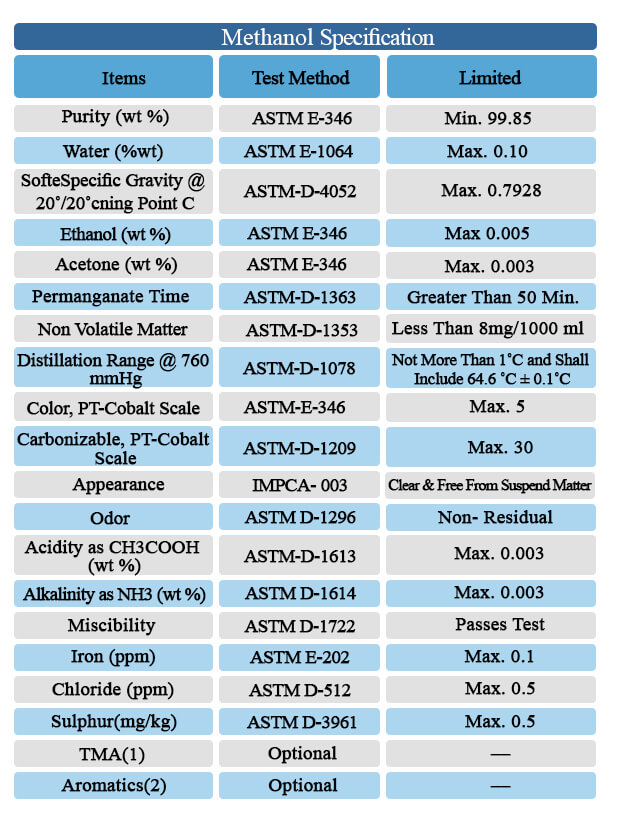Methanol Also known as methyl alcohol, wood alcohol, wood naphtha, methyl hydrate, or wood spirits, is a chemical with the formula CH3OH (often abbreviated MeOH). Methanol acquired the name wood alcohol because it was once produced chiefly as a byproduct of the destructive distillation of wood. Today, industrial methanol is produced in a catalytic process directly from carbon monoxide, carbon dioxide, and hydrogen.
Methanol is the simplest alcohol, being only a methyl group linked to a hydroxyl group. It is a light, volatile, colorless, flammable liquid with a distinctive odor very similar to that of ethanol (drinking alcohol). However, unlike ethanol, methanol is highly toxic and unfit for consumption. At room temperature, it is a polar liquid, and is used as an antifreeze, solvent, fuel, and as a denaturant for ethanol. It is also used for producing biodiesel via transesterification reaction.
Methanol is produced naturally in the anaerobic metabolism of many varieties of bacteria, and is commonly present in small amounts in the environment. As a result, the atmosphere contains a small amount of methanol vapor. But in only a few days, atmospheric methanol is oxidized by sunlight to produce carbon dioxide and water.
Methanol is also found in abundant quantities in star-forming regions of space, and is used in astronomy as a marker for such regions. It is detected through its spectral emission lines.
Methanol burns in oxygen, including open air, forming carbon dioxide and water:
2 CH 3OH + 3 O2 2 CO2+ 4 H 2O
Methanol ingested in large quantities is metabolized first to formaldehyde and then to formic acid or formate salts, which are poisonous to the central nervous system and may cause blindness, coma, and death. Because of these toxic properties, methanol is frequently used as a denaturant additive for ethanol manufactured for industrial uses. This addition of methanol exempts industrial ethanol (commonly known as denatured alcohol or methylated spirit) from liquor excise taxation in the US and some other countries.
Applications
Methanol is used primarily as a feedstock for the manufacture of chemicals, and as a fuel for specialized vehicles. As mentioned above, it is a common de-naturing agent. As a common laboratory solvent, is especially useful for HPLC, UV/VIS spectroscopy, and LCMS due to its low UV cutoff.
Chemical industry
Methanol is primarily used in making other chemicals. About 40% of methanol is converted to formaldehyde, and from there into products as diverse as plastics, plywood, paints, explosives, and permanent press textiles.
Other chemical derivatives of methanol include dimethyl ether (DME), which has replaced chlorofluorocarbons as an aerosol spray propellant, and acetic acid. Dimethyl ether can be blended with liquified petroleum gas (LPG) for home heating and cooking, and can be used as a replacement for transportation diesel fuel.
Of high interest to the petrochemical marketplace, methanol is an important ingredient in new and lower-cost methods for producing propylene, which is much in demand. Such methods include Methanol-to-Olefins (MTO), Methanol-to-Propylene (MTO/MTP), Metathesis, Propane Dehydrogenation (PDH), High Severity FCC, and Olefins Cracking.
The market for proponyl became tight when the ethane prices fell in the USA with the exploration of shale gas reserves. The low priced ethylene produced from this raw material has given chemical producers in North America a feedstock advantage. Such change has put naphtha-fed steam crackers at a disadvantageous position, with many of them shutting down or revamping to use ethane as a feedstock. Nevertheless, the propylene output rates from ethane-fed crackers are negligible.
Other applications
Methanol is a traditional denaturant for ethanol, the product being known as denatured alcohol or methylated spirit. This was commonly used during the Prohibition to discourage consumption of bootlegged liquor, and ended up causing several deaths.
Methanol is used as a solvent and as an antifreeze in pipelines and windshield washer fluid.
In some wastewater treatment plants, a small amount of methanol is added to wastewater to provide a carbon food source for the denitrifying bacteria, which convert nitrates to nitrogen gas and reduce the nitrification of sensitive aquifers.
During World War II, methanol was used as a fuel in several German military rocket designs, under the name M-Stoff, and in a roughly 50/50 mixture with hydrazine, known as C-Stoff.
Methanol was used as an automobile coolant antifreeze in the early 1900s.
Methanol is used as a destaining agent in polyacrylamide gel electrophoresis.
Direct-methanol fuel cells are unique in their low temperature, atmospheric pressure operation, allowing them to be miniaturized to an unprecedented degree. This, combined with the relatively easy and safe storage and handling of methanol, may open the possibility of fuel cell-powered consumer electronics, such as laptop computers and mobile phones.
Methanol is also a widely used fuel in camping and boating stoves. Methanol burns well in an unpressurized burner, so alcohol stoves are often very simple, sometimes little more than a cup to hold fuel. This lack of complexity makes them a favorite of hikers who spend extended time in the wilderness. Similarly, the alcohol can be gelled to reduce the risk of leaking or spilling, as with the brand Sterno.
Methanol is mixed with water and injected into high-performance diesel and gasoline engines for an increase of power and a decrease in intake air temperature in a process known as water methanol injection.

Comments Off on Methanol with 487 visit